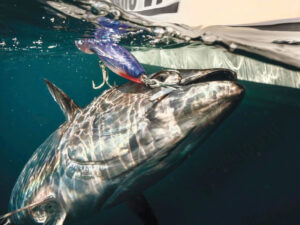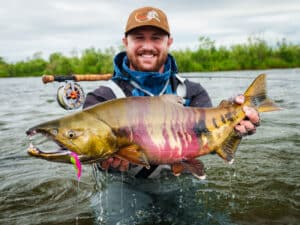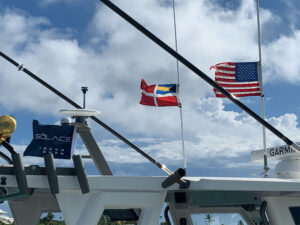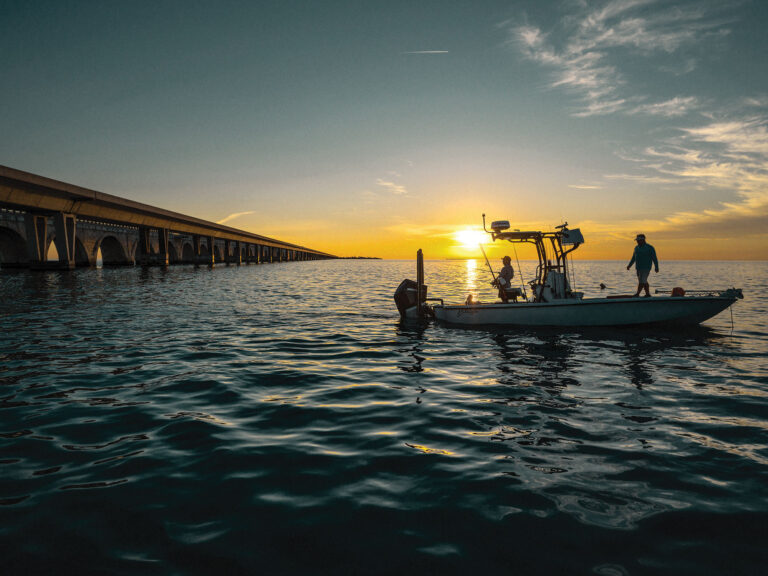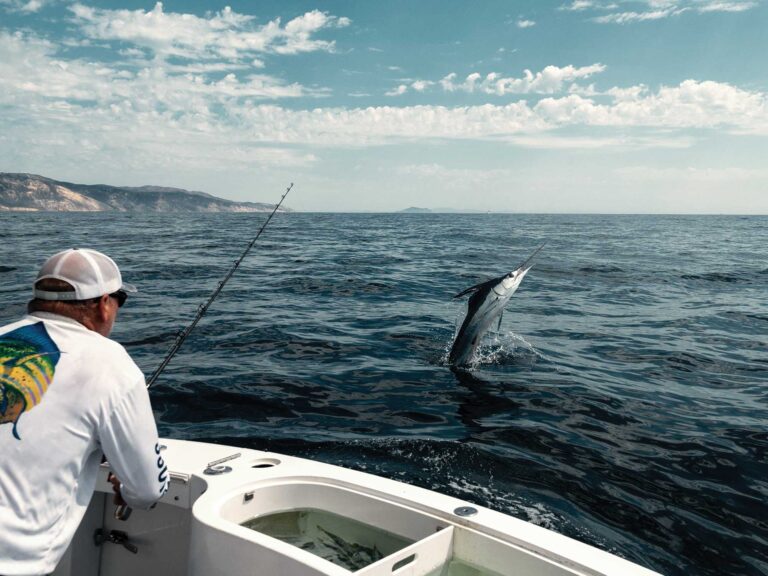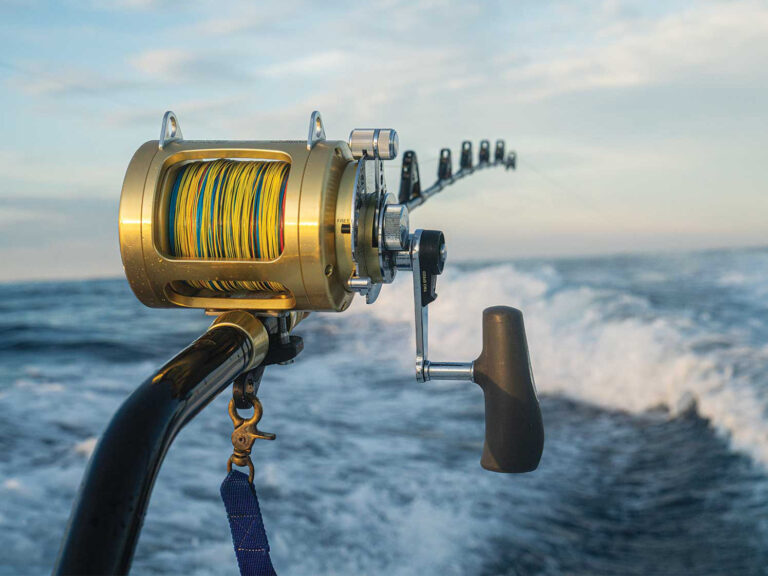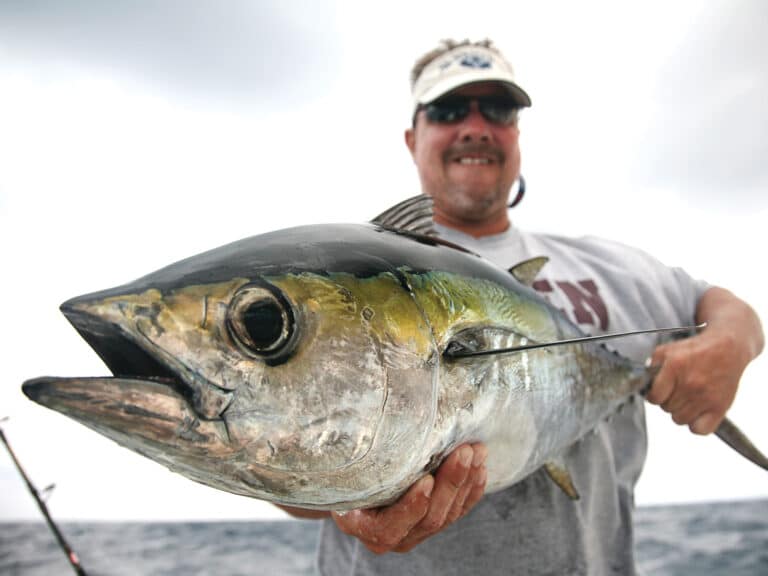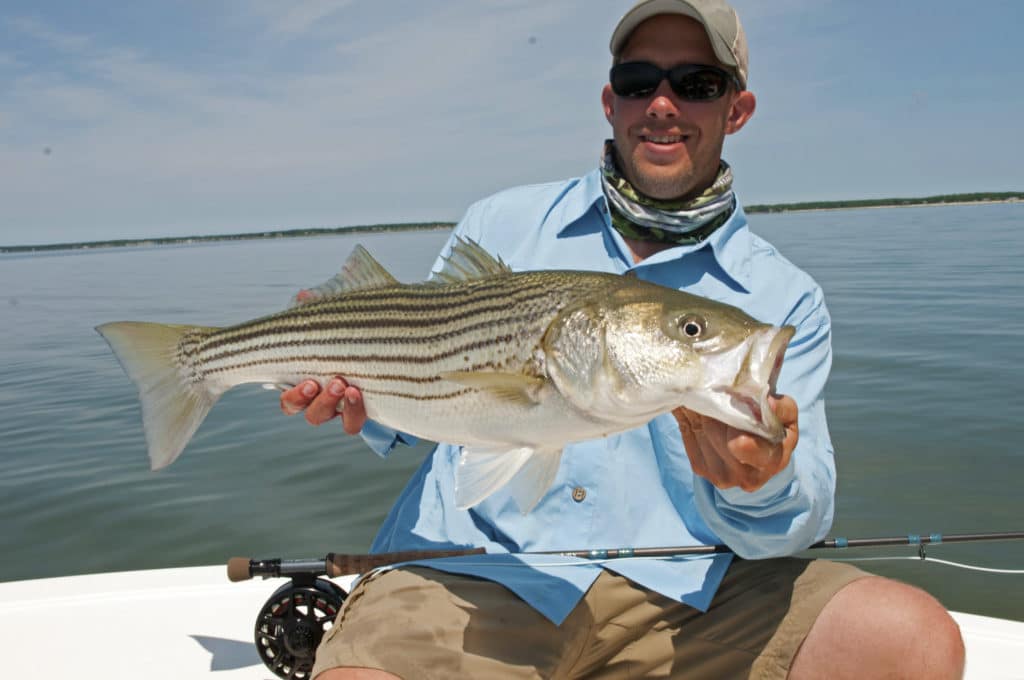
For many anglers, sight-casting is the ultimate challenge, an addictive combination of fishing and hunting. There’s nothing quite like the thrill of seeing your target swimming along, doing its thing, then making the perfect cast and watching the fish react and attack. And if all this happens to take place on a beautiful white-sand flat in less than three feet of water, so much the better!
Up until the ’90s, the sight-casting game was confined mostly to southern waters and species such as permit, red drum, bonefish and seatrout. Then the fact that striped bass and even bluefish frequented shallow, sandy areas of the Mid-Atlantic and Northeast became widely publicized, and suddenly a whole new segment of the anglingpopulation began to enjoy the excitement of flats fishing.
While certain spots get the lion’s share of attention when it comes to sight-fishing for striped bass (Cape Cod and eastern Long Island come to mind), there are hundreds of places where you can find stripers and blues cruising in knee-high water or less. These spots range from exposed beaches to backwater marshes and bays, places that are easily accessible by small boat or even on foot. Chances are there are some prime flats near you that are crawling with fish. You just have to open your eyes!
Capt. Paul Dixon, Long Island, New York
One of the early pioneers of Northeast sight-fishing is Captain Paul Dixon, who fishes the prolific flats off Gardiners Island and East Hampton on eastern Long Island, New York. According to Dixon, prime flats fishing here begins on late spring and runs through July, although the fish’s exact date of arrival can vary by two weeks. “Every year is different,” says Dixon. “In a cold year, like we’re having now, the stripers may not show on the flats until the first week in June. If we have a warm winter and spring, we may see them in mid-May. However, I can pretty much guarantee that my clients will see a lot of fish if they book a trip between June 15 and July 15.”
Dixon likes to fish the bottom of the dropping tide and the first two hours of the rising. “You need low water to see the fish well,” he explains. “When it’s too high, you may have trouble seeing the fish.” High water may also present a problem in terms of being able to get the fly or lure down to its level in time. Lastly, it may give the fish more room to spread out, whereas low tide may concentrate them.
A great place to sight-fish for stripers is along the edge of a channel. The fish will often move out of the deep water to forage briefly in the shallows, making themselves visible targets.
“The number-one rule is tide, tide, tide,” Dixon says emphatically. “Moving water is the essence, the key to everything, no matter what kind of fishing you’re doing. Always check to see when the tide will be moving before your trip. You want current to be sweeping baitfish and crabs along to the fish. If all other conditions are perfect and you are seeing fish, but they are not paying attention to your lure or fly, it’s probably the tide. Always note the stage of the tide and the time of day when you find fish, as they’ll probably be there again the next day at the same stage.”
Although calm conditions may make it easier to cast far and accurately, Dixon prefers a bit of wind. “The wind is your friend. You have to have some sort of chop in order to see the fish, as the riffles provide a kind of window that breaks the surface glare. You don’t want it flat-calm, because the fish can see you.”
Most of Dixon’s charter customers use fly gear, but he has had success with lures fished on spinning gear. “I have found that flies can be more effective because they land gently, which doesn’t spook the fish. However, soft-plastic baits (such as four- to six-inch Slug-Gos) in white, silver/white and red/white work well, too, as long as you cast them well beyond and ahead of the fish and retrieve it into its field of vision.” Dixon recommends leading the fish by at least 15 feet, and says to make sure the bait swims away from its attacker. “That’s more important than anything,” he says. “There are no suicidal baitfish!”
Alan Caolo’s Sight-Fishing for Striped Bass (Frank Amato Publications; ISBN 1571882537) is packed with how-to information that will prove invaluable to anglers interested in Northeast flats fishing, no matter what their level of experience. Caolo covers the gambit, from shallow-water prey items to striper behavior to appropriate tackle, clothing and flies for fishing the flats. There’s even a chapter on productive sight-casting destinations, complete with spectacular aerial photography and highlighted chart sections. And speaking of photography, the book is loaded with large color shots of bait species, tackle, flies and sensational photos of stripers cruising the flats. Anyone who’s addicted to chasing stripers in skinny water – or who wants to learn how to do it – should get this book. It’s available for $25 (paperback), and can be ordered through the publisher’s website at www.amatobooks.com. or by calling (800) 541-9498. – Ed.
Flies are a different matter, and can be placed much closer to the fish’s nose. As far as patterns are concerned, Dixon prefers 1/0 to No. 2 brown-and-white and green-and-white Clousers and Deceivers for flats fishing, as well as grass-shrimp patterns. He fishes all his flies on super-long fluorocarbon leaders. “I always use a 12- to 16-foot leader made of 16- to 20-pound fluoro. Any shorter and the fish will notice the fly line.”
Capt. Jim Ellis, Cape Cod Bay, Massachusetts
“Where you find a flat, you’ll find fish.” So says Captain Jim Ellis, an experienced sight-fishing guide whose home turf is Cape Cod Bay in Massachusetts. Essentially, the entire inner arm of the Cape is one long sand flat with the potential to offer great sight-fishing, although Ellis primarily works the area from Barnstable Harbor to Brewster. To the novice angler, the sheer size of these flats can be somewhat intimidating (where does one start?); however, careful observation will reveal scads of fishy clues.
“The best thing you can do is visit the flat during a low spring- or new-moon tide, when the bottom is exposed. You will see little depressions or troughs that may be just six inches deeper than the surrounding bottom, and these spots will hold fish. Make note of them and come back when the water is high. However, be aware that the bottom will change due to storms, so you need to revisit the flats from time to time.”
While Ellis sometimes poles his 16-foot Maritime Skiff, he notes that the strong currents in Cape Cod Bay often make this a difficult task. Drifting is a good way to cover ground while looking for fish, and Ellis often employs a sea anchor to slow the drift. He also likes to run to hard-to-reach or lightly fished areas where his customers can wade. “What I’ve been doing more and more is having my anglers get out of the boat and wade the rising tide. It’s often easier for them to control their fly line while wading. When the water gets too high, we hop back in the boat and run to another wadable spot.” Over the years, Ellis has created a number of fishing routes based on the tide, and always knows a place that’s likely to produce.
He is quick to point out that the more popular spots can become overfished. It’s not that the fish aren’t there; it’s just that they have become wary of anglers and their lures.
“By mid- to late July, you know that the stripers in the heavily fished spots have seen everything,” he says. “That’s why I like to get away from the crowds. I’ll run a good distance to places that no one else fishes. I call these ‘bathing beach’ flats – small, narrow strips of sand that run parallel to the beaches. These flats aren’t big, but they hold fish. You can wade the flat or drift along it and watch fish coming out of the deeper water on either side. These fish are often easier to see, too, as they take on a darker color from spending more time in the deeper water. The fish that spend all their time on a shallow sand bottom take on a very light color and can be very hard to see.”
Ellis’s favorite sight-fishing conditions include a light breeze and a low tide occurring anywhere from 10:00 in the morning until 2:00 in the afternoon, when the sun is highest. “The ideal would be a slack low at noon,” he says. “That way I can fish the last of the dropping when the fish are vacating the flat, take a break for lunch at slack, then fish the first of the rising as the fish are concentrated and moving onto the flats. The incoming tide is best.”
Like most flats guides, Ellis prefers to use fly tackle, as flies land more quietly than other lures and are better at imitating the small baitfish that swarm the shallows of Cape Cod Bay. However, he says that four- or six-inch Slug-Gos and similar soft-plastic baits also take plenty of fish. These baits can be fished on small jigheads to get them deep, but work best when rigged weedless and twitched on or just below the surface. Best colors are white and bubblegum.
TV Show Highlights Northeast Fishing
You can’t say that David Sloan doesn’t enjoy his job. Each week, the enthusiastic host of the TV show “On the Hook” travels to different parts of the Northeast in search of new species and adventures. Along the way he joins forces with local charter captains and other experts who provide valuable fishing insights – and more than a few laughs. There’s even a great segment on cooking your catch, with recipes provided by well-known area chefs. This season’s episodes cover major local game fish ranging from cod to stripers to bluefin tuna, and, as always, feature lots of how-to information on rigging and fishing techniques. Be sure to catch “On the Hook” every Friday at 5:00 p.m. on NESN. For more information, check out www.onthehooktv.com. – Ed.
“Ninety-nine percent of the bait on the Cape Cod flats are sand eels,” Ellis says. “So I use small, sparsely tied sand-eel patterns such as Bob Popovics’ Surf Candy. A new pattern that has been producing lots of action lately is Skok’s Pheasant Phlounder Fly, which imitates a baby flounder. It worked very well on the flats last season.” Ellis adds that he doesn’t like a lot of flash in his flies, and often has his clients trim the excess flashy material from their store-bought creations. “It’s really easy to over-flash a fly,” he says. “The less flash the better!”
As any flats fisherman will tell you, there are times when stripers develop lockjaw and won’t touch a thing. When this happens, Ellis recommends a bigger fly that gets the fish’s attention. “Take a bigger, heavier fly, like a large Clouser, and plop it down on the surface near the fish. Sometimes the fish will spin around and hit that fly like he’s pissed off.” Ellis also recommends varying the retrieve, either faster or slower, if the fish aren’t interested in the one you’re using. “And clean your hands well,” he adds, “especially if you’ve been touching any sunblock.”
Another trick Ellis uses is to present his flies on a fast sink-tip or heavy-grain sinking line. This takes the fly to the bottom quickly, where it may get the attention of a fish that’s intently scanning the bottom for food. Flies fished on floating or intermediate lines are often ignored by fish cruising just a few feet down.
Ellis generally makes his first flats forays in late May, and reports that the action remains pretty consistent through the summer on the north side of Cape Cod Bay, where the water stays fairly chilly. But while many anglers feel that the only sight-fishing is available on the sandy, open flats, Ellis points out that the marshes and mud flats deep inside the harbors also offer excellent action, especially in May and early June. In these dark-bottomed areas, the best bet is to look for surface disturbances caused by the fish as they feed and cruise.
Alan Caolo, Rhode Island
Another sight-fishing expert who enjoys success in protected backwaters is Alan Caolo, author of Sight-Fishing for Striped Bass. Caolo explains that marshes, back bays and estuaries attract the majority of bass in the very early season (mid-May to early June), namely because these places offer plenty of food and warmer water temperatures. He likes to fish an incoming afternoon tide at this time, when the stripers typically will seek out sun-warmed mud flats. These backwater bass are sometimes hard to see, but often give themselves away by tailing or creating swirls and wakes.
At this time of year, the stripers are feeding on a wide variety of prey, including green crabs, flounder, grass shrimp and worms. These creatures live on the bottom, which is why you’ll often see the fish tailing as they tip down to root in the mud. Good lures for these waters include 1/8- or 1/4-ounce brown or tan bucktail jigs (Caolo mentions that Phillips Wiggle Jigs are good) and those rigged with small curl-tail grubs. Slug-Gos, Fin-S-Fish and other soft-plastic baits also draw strikes when twitched on or just off the bottom.
Come June, the stripers start to drop out of the sheltered backwater areas and into the open ocean, where they roam the beach edges in search of baitfish and crabs. This is when Caolo, who does most of his sight-fishing on foot, starts walking the beaches, looking for fish in the wash. He points out that once the spring migration period is over, many stripers depart for other coastal locales. However, some fish stay and become residents; they stick around all season. “You won’t see big schools along the beaches,” he says. “Instead, it’s mostly singles and doubles. These fish are not as aggressive, either, so your presentation has to be more precise. The fish are spread out, and they are selective because they are feeding less. The fishing gets tough – it’s very similar to bonefishing. You have to earn every fish.”
Ocean conditions can also make beachfront fishing a challenge. For example, heavy surf can kick up weeds and sand, roiling the water for days. This can keep the fish in deeper water or make them hard to see. On the other hand, calm periods can yield awesome action, even during the supposed doldrums of summer when many anglers think the biggest bass are sulking in deep water. “August is my best month in terms of numbers of big fish,” Caolo says, adding that he almost always sees fish while walking the beaches. During these forays, he keeps an eye out for crab shells and baitfish that may have washed up on shore. This helps him determine what fly or lure to tie on.
Northeast Flats Guides
To book a trip with the flats guides mentioned in this article, contact:
Capt. Paul Dixon: (631) 329-6186, www.flyfishingmontauk.com
Capt Jim Ellis: (508) 362-9108, www.saltwaterflies.com/haystaddle
When Caolo spies a striper, the first thing he does is observe it. “I try to get a read on its behavior to find out what it’s eating. If the fish is moving along slowly near the bottom and tipping down occasionally, it’s looking for little bits of movement, eye stalks poking out of the sand, that sort of thing. It’s concentrating very hard. In this case you want to present a crab fly very close to the fish or it won’t see it.” On the other hand, with a striper that’s darting through the surf, chasing baitfish in the wash, the angler can lead it a bit more and strip faster.
If the fish refuses your offering or doesn’t see it, don’t give up. “The great thing about beachfront fishing is that you can often get multiple shots at the same fish,” says Caolo. “That’s because the fish is usually focused on working the intertidal zone where the food is. Just stay calm and watch the fish for a moment before getting into casting position.”
Like Ellis and Dixon, Caolo prefers flies when stalking stripers along the beach. His list of essential patterns includes a No. 2 olive/grey Half-and-Half, a No. 2 Skok’s Pheasant Phlounder, a No. 2 Green Diablo (a green-crab imitation), and a No. 4 Ray’s Fly Bendback.
1) Low tide is a good time to scout out prospective flats for edges and depressions where stripers may gather on high water.
2) In northern waters, seals can really mess up the flats fishing in some spots by spooking the fish.
3) Marsh banks provide a natural edge along which stripers tend to cruise during high tide. Note the electric-blue tint on this fish’s tail and dorsal fins as it searches for a meal on the bottom.
4) Crabs are an important food source for bass on the flats, which is good reason to pack some crab-imitating flies and soft-plastics.
5) Sandy beaches hold big stripers all season long. Look for them in the wave faces very close to shore.

